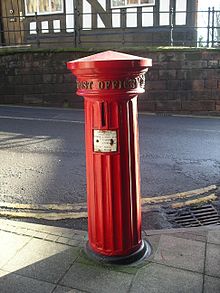
A pillar box is a type of free-standing post box. They are found in the United Kingdom and its associated the Crown Dependencies and British Overseas Territories, and, less commonly, in many members of the Commonwealth of Nations such as Cyprus, India, Gibraltar, Hong Kong, Malta, New Zealand and Sri Lanka, as well as in the Republic of Ireland. Pillar boxes were provided in territories administered by the United Kingdom, such as Mandatory Palestine, and territories with agency postal services provided by the British Post Office such as Bahrain, Dubai, Kuwait and Morocco. The United Kingdom also exported pillar boxes to countries that ran their own postal services, such as Argentina, Portugal and Uruguay.
Mail is deposited in pillar boxes to be collected by the Royal Mail, An Post or the appropriate postal operator and forwarded to the addressee. The boxes have been in use since 1852, just twelve years after the introduction of the first adhesive postage stamps (Penny Black) and uniform penny post.
Mail may also be deposited in lamp boxes or wall boxes that serve the same purpose as pillar boxes but are attached to a post or set into a wall. According to the Letter Box Study Group, there are more than 150 recognised designs and varieties of pillar boxes and wall boxes, not all of which have known surviving examples. Like the red telephone box, the red post box is regarded as a British cultural icon. As of 2002[update], Royal Mail estimates there are over 115,000 post boxes in the United Kingdom.[1]
- ^ "Campaign to preserve red post boxes". BBC News. 3 October 2002. Retrieved 23 March 2007.
